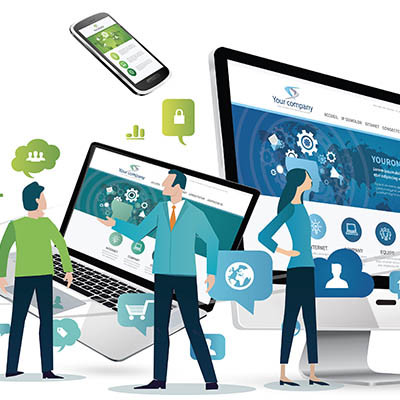SolutionOne Blog
More businesses than ever before are seeing the value of outsourcing their technology management to a managed service provider (MSP) and it’s easy to see why. With a more hands-off approach to technology management, businesses can focus on delivering quality goods and services instead of worrying about their technology. If you are considering jumping on the MSP wagon, consider asking the following questions to make sure you understand what you are getting from your provider.
It doesn’t matter if your workplace is your typical office space or if it is remote. There will always be factors that can contribute to burnout. These struggles are not exclusive to the location of the office, and if left unchecked they can impact work performance, productivity, mental health, and so on. It’s important that you have coping mechanisms and strategies in place to address burnout before it becomes too severe to counter.
We often think about disasters in the context that they completely destroy the office, rendering your business incapable of operations. However, this is only part of what is encompassed by the term “disaster,” and the whole picture is far more terrifying. Any disruption to your operations can be considered a disaster in its own right, so we wanted to take some time to go over what you should look out for with your disaster planning.
There are countless ways your organization could face down a disaster, whether it’s a high-profile natural disaster, a physical disaster, or a technology-related disaster. If you aren’t prepared to face the consequences, your business could falter in the face of such incidents. How can your business best prepare itself for all manners of disasters?
While we’re all for efficiency, there are some boundaries that should not be crossed for everyone’s benefit. Take, for instance, the email you use to subscribe to online services. While it may be tempting (or, for some people, automatic) to use your work email address when you sign up for, say, your Netflix account or an online merchant, we wanted to discuss why this is a bad habit to get into that could have lasting consequences.
We’re coming up on two years since the COVID-19 pandemic changed many workplaces’ operational strategies from in-person work to remote work. In that time, many businesses who hadn’t initially considered remote working to be a viable option have now made it a core part of their onboarding process. This means there are plenty of workers who are now beginning remote work who haven’t really experienced it before. Today, we thought we’d go through a couple of strategies that will help remote employees be as productive as possible as they work from home.
The holidays are times for people to come together, even in these incredibly stressful times, so you’ll want to make sure that you are taking all the necessary precautions on both a personal level and a technological level. Here are some ways that you can keep yourself safe from a technology perspective this holiday season.
Technology is one element that many small businesses struggle with, but it turns out that a lot of the same advice that you might get for regular life lessons can also apply to IT! Let’s take a closer look at how we might apply some of these lessons and why it just makes good sense to keep these tips close at hand.
What do you do with your old email messages? Do they just sit around in your inbox and collect dust? If so, this is certainly a wasteful practice, as those emails can accrue over time and take up a sizable chunk of space. The question then becomes, what do you do with the emails to keep them from taking up so much space, especially when you might be paying for the space?
Regular computer maintenance is part of maintaining healthy IT infrastructure, but one aspect that can often go by the wayside is keeping your computer physically clean. By this, we mean keeping it dust-free, clean and tidy. We’ve put together a shortlist of everyday actions that employees of any caliber can use to keep their workstations clean. This will help your organization take preventative measures over time and (hopefully) prolong the lifespan of your business’ technology.
For decades, technology has been the driving force behind some of the biggest and most radical shifts in business. Therefore, it makes sense to assume that the keys to your organization pushing past its limits and becoming truly exceptional lies in the implementation of new technologies that change operations in a profound way. The process of digital transformation does not have to be difficult, but it is important in a business environment so that you can stay competitive.
You may have been in a position where you tried to implement a technology solution in the past only to find that your staff is simply not responsive to it in any capacity. Maybe they do not see the value in the solution, or they do not understand what issues the solution resolves for your organization. To help you instill the correct mindset in your employees regarding technology, here are some training tips!
As a business owner, we are sure that you have your fair share of day-to-day stressors. Oftentimes, these stressors can lead to the development of bad habits. When this happens, you might get the urge to correct the bad behavior and replace it with good, productive habits. That said, it’s easier said than done to build good habits, especially when you have so much else on your plate.
For some companies, their IT is like a boat to a fisherman: they could conceivably do the work without it, but they wouldn’t have a business. For this reason it is important to know how to ascertain which technology investments are right for your business at any given time. Let’s go through a few considerations decision makers should highlight when choosing new technology for their businesses.
If you are looking for a way to smooth out the edges of your business, consider putting together a knowledge base that includes all policies, procedures, and other information so it is readily accessible by the people that interact within and from outside your business. Businesses that have well-documented policies and procedures have a tendency to have less difficulty onboarding new hires, fewer operational problems, and can always provide access to resources needed by employees, customers, and vendors. Today we will give you a few tips on how to successfully create a working knowledge base.
It’s no secret that new technology can be useful for a business, unfortunately too many businesses struggle with their technology implementations. When adding new tools to your business, you will need to understand that the more deliberate you are, the more success you will find. Rushing any new deployment is sure to have some types of issues. For today’s blog, we take you through some of the best practices of adding new technology to your business.
When we say “improve communications” you probably are expecting an article about telephone systems or which video conferencing platform works the best. Normally, you’d be right, but today we decided to briefly go over four ways that you can foster better communications between management and their employees inside of your business.
I hope I don’t have to tell you how important your business’ data is to its continued survival, just as I hope I don’t need to explain why this makes this data a priority to protect, regardless of your business’ size. What I do want to explain is the concept of the 3-2-1 Rule and how it pertains to your data backup, and why we would recommend that one for your business’ purposes.



















